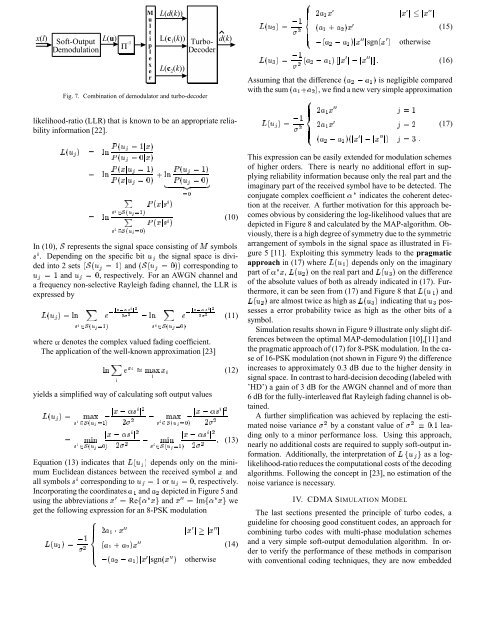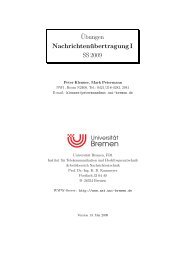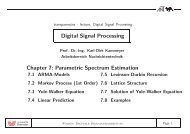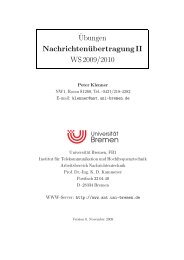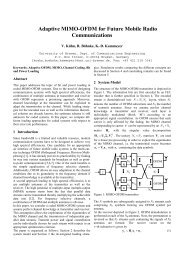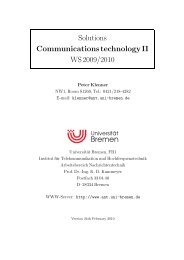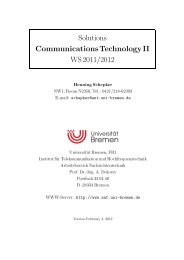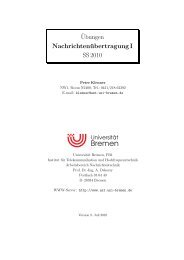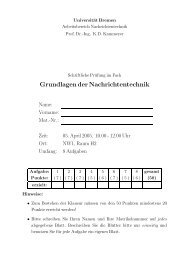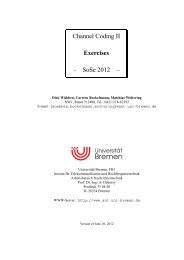Evaluating the Performance of Turbo Codes and Turbo-Coded ...
Evaluating the Performance of Turbo Codes and Turbo-Coded ...
Evaluating the Performance of Turbo Codes and Turbo-Coded ...
Create successful ePaper yourself
Turn your PDF publications into a flip-book with our unique Google optimized e-Paper software.
x(l)<br />
S<strong>of</strong>t-Output<br />
Demodulation<br />
L(u)<br />
Π -1<br />
M<br />
u<br />
l<br />
t<br />
i<br />
p<br />
l<br />
e<br />
x<br />
e<br />
r<br />
L(d(k))<br />
L(c 1 (k))<br />
L(c 2 (k))<br />
<strong>Turbo</strong>-<br />
Decoder<br />
Fig. 7. Combination <strong>of</strong> demodulator <strong>and</strong> turbo-decoder<br />
d(k)<br />
likelihood-ratio (LLR) that is known to be an appropriate reliability<br />
information [22].<br />
Ä´Ù µ ÐÒ È ´Ù ½Üµ<br />
È ´Ù ¼Üµ<br />
<br />
<br />
ÐÒ È ´ÜÙ ½µ<br />
È ´ÜÙ ¼µ·ÐÒÈ ´Ù ½µ<br />
È ´Ù ¼µ<br />
ÐÒ<br />
È<br />
È ´Ü× µ<br />
× ¾Ë´Ù<br />
È<br />
½µ<br />
È ´Ü× µ<br />
× ¾Ë´Ù ¼µ<br />
ßÞ Ð<br />
¼<br />
(10)<br />
In (10), Ë represents <strong>the</strong> signal space consisting <strong>of</strong> Å symbols<br />
× . Depending on <strong>the</strong> specific bit Ù <strong>the</strong> signal space is divided<br />
into 2 sets ´Ë´Ù ½µ<strong>and</strong> ´Ë´Ù ¼µµ corresponding to<br />
Ù ½ <strong>and</strong> Ù ¼, respectively. For an AWGN channel <strong>and</strong><br />
a frequency non-selective Rayleigh fading channel, <strong>the</strong> LLR is<br />
expressed by<br />
<br />
<br />
Ä´Ù µÐÒ Ü «× ¾<br />
¾ ¾ ÐÒ Ü «× ¾<br />
¾ ¾ (11)<br />
× ¾Ë´Ù ½µ × ¾Ë´Ù ¼µ<br />
where « denotes <strong>the</strong> complex valued fading coefficient.<br />
The application <strong>of</strong> <strong>the</strong> well-known approximation [23]<br />
ÐÒ<br />
<br />
<br />
Ü ÑÜ Ü (12)<br />
<br />
yields a simplified way <strong>of</strong> calculating s<strong>of</strong>t output values<br />
Ä´Ù µ<br />
<br />
Ü «× ¾<br />
ÑÜ<br />
× ¾Ë´Ù ½µ ¾ ¾<br />
Ü «× ¾<br />
ÑÒ<br />
× ¾Ë´Ù ¼µ ¾ ¾<br />
Ü «× ¾<br />
ÑÜ<br />
× ¾Ë´Ù ¼µ ¾ ¾<br />
Ü «× ¾<br />
ÑÒ<br />
(13)<br />
× ¾Ë´Ù ½µ ¾ ¾<br />
Equation (13) indicates that Ä´Ù µ depends only on <strong>the</strong> minimum<br />
Euclidean distances between <strong>the</strong> received symbol Ü <strong>and</strong><br />
all symbols × corresponding to Ù ½or Ù ¼, respectively.<br />
Incorporating <strong>the</strong> coordinates ½ <strong>and</strong> ¾ depicted in Figure 5 <strong>and</strong><br />
using <strong>the</strong> abbreviations Ü ¼ Re« £ Ü <strong>and</strong> Ü ¼¼ Im« £ Ü we<br />
get <strong>the</strong> following expression for an 8-PSK modulation<br />
Ä´Ù ½ µ<br />
<br />
½<br />
¾ <br />
¾ ½ ¡ Ü ¼¼<br />
´ ½ · ¾ µÜ ¼¼<br />
Ü ¼ Ü ¼¼ <br />
´ ¾ ½ µÜ ¼ sgn´Ü ¼¼ µ o<strong>the</strong>rwise<br />
(14)<br />
¾<br />
½ Ü ¼<br />
Ü ¼ Ü ¼¼ <br />
Ä´Ù ¾ µ<br />
½<br />
´<br />
¾ ½ · ¾ µÜ ¼<br />
(15)<br />
´ ¾ ½ µÜ ¼¼ sgn´Ü ¼ µ o<strong>the</strong>rwise<br />
Ä´Ù ¿ µ<br />
½<br />
´ ¾ ¾ ½ µÜ ¼ Ü ¼¼ ℄ (16)<br />
Assuming that <strong>the</strong> difference ´ ¾ ½ µ is negligible compared<br />
with <strong>the</strong> sum ´ ½· ¾ µ,wefind a new very simple approximation<br />
Ä´Ù µ<br />
<br />
½<br />
¾ <br />
¾ ½ Ü ¼¼<br />
¾ ½ Ü ¼<br />
½<br />
¾<br />
´ ¾ ½ µ´Ü ¼ Ü ¼¼ µ ¿<br />
(17)<br />
This expression can be easily extended for modulation schemes<br />
<strong>of</strong> higher orders. There is nearly no additional effort in supplying<br />
reliability information because only <strong>the</strong> real part <strong>and</strong> <strong>the</strong><br />
imaginary part <strong>of</strong> <strong>the</strong> received symbol have to be detected. The<br />
conjugate complex coefficient « £ indicates <strong>the</strong> coherent detection<br />
at <strong>the</strong> receiver. A fur<strong>the</strong>r motivation for this approach becomes<br />
obvious by considering <strong>the</strong> log-likelihood values that are<br />
depicted in Figure 8 <strong>and</strong> calculated by <strong>the</strong> MAP-algorithm. Obviously,<br />
<strong>the</strong>re is a high degree <strong>of</strong> symmetry due to <strong>the</strong> symmetric<br />
arrangement <strong>of</strong> symbols in <strong>the</strong> signal space as illustrated in Figure<br />
5 [11]. Exploiting this symmetry leads to <strong>the</strong> pragmatic<br />
approach in (17) where Ä´Ù ½ µ depends only on <strong>the</strong> imaginary<br />
part <strong>of</strong> « £ Ü, Ä´Ù ¾ µ on <strong>the</strong> real part <strong>and</strong> Ä´Ù ¿ µ on <strong>the</strong> difference<br />
<strong>of</strong> <strong>the</strong> absolute values <strong>of</strong> both as already indicated in (17). Fur<strong>the</strong>rmore,<br />
it can be seen from (17) <strong>and</strong> Figure 8 that Ä´Ù ½ µ <strong>and</strong><br />
Ä´Ù ¾ µ are almost twice as high as Ä´Ù ¿ µ indicating that Ù ¿ possesses<br />
a error probability twice as high as <strong>the</strong> o<strong>the</strong>r bits <strong>of</strong> a<br />
symbol.<br />
Simulation results shown in Figure 9 illustrate only slight differences<br />
between <strong>the</strong> optimal MAP-demodulation [10],[11] <strong>and</strong><br />
<strong>the</strong> pragmatic approach <strong>of</strong> (17) for 8-PSK modulation. In <strong>the</strong> case<br />
<strong>of</strong> 16-PSK modulation (not shown in Figure 9) <strong>the</strong> difference<br />
increases to approximately 0.3 dB due to <strong>the</strong> higher density in<br />
signal space. In contrast to hard-decision decoding (labeled with<br />
’HD’) a gain <strong>of</strong> 3 dB for <strong>the</strong> AWGN channel <strong>and</strong> <strong>of</strong> more than<br />
6 dB for <strong>the</strong> fully-interleaved flat Rayleigh fading channel is obtained.<br />
A fur<strong>the</strong>r simplification was achieved by replacing <strong>the</strong> estimated<br />
noise variance ¾ by a constant value <strong>of</strong> ¾ ¼½ leading<br />
only to a minor performance loss. Using this approach,<br />
nearly no additional costs are required to supply s<strong>of</strong>t-output information.<br />
Additionally, <strong>the</strong> interpretation <strong>of</strong> Ä Ù as a loglikelihood-ratio<br />
reduces <strong>the</strong> computational costs <strong>of</strong> <strong>the</strong> decoding<br />
algorithms. Following <strong>the</strong> concept in [23], no estimation <strong>of</strong> <strong>the</strong><br />
noise variance is necessary.<br />
IV. CDMA SIMULATION MODEL<br />
The last sections presented <strong>the</strong> principle <strong>of</strong> turbo codes, a<br />
guideline for choosing good constituent codes, an approach for<br />
combining turbo codes with multi-phase modulation schemes<br />
<strong>and</strong> a very simple s<strong>of</strong>t-output demodulation algorithm. In order<br />
to verify <strong>the</strong> performance <strong>of</strong> <strong>the</strong>se methods in comparison<br />
with conventional coding techniques, <strong>the</strong>y are now embedded


